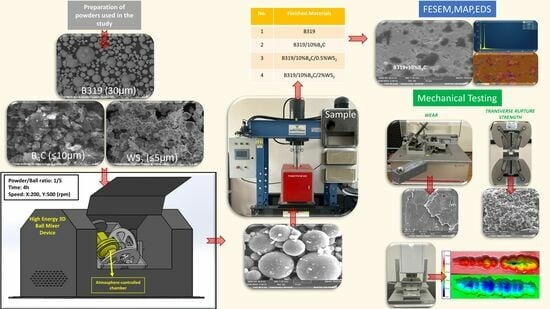Microstructure, Mechanical Strength, and Tribological Behavior of B4C/WS2-Hybrid-Reinforced B319 Aluminum Matrix Composites
Abstract
1. Introduction
2. Experimental Procedure
2.1. Fabrication of B319/B4C/WS2 Hybrid Composite Specimens
2.2. Microstructure and Mechanical Analysis
3. Results and Discussion
3.1. Characterization of Starting Powder Materials
3.2. Microstructure Characterization of Materials
3.3. Physical and Mechanical Properties
3.4. Transverse Rupture Strength Analysis
3.5. Frictional and Wear Analysis
4. Conclusions
Funding
Data Availability Statement
Conflicts of Interest
References
- Pillari, L.K.; Lessoway, K.; Bichler, L. Reciprocating Dry Sliding Friction and Wear Behavior of B319 Aluminum Alloy-Graphene Composites. Tribol. Int. 2024, 192, 109334. [Google Scholar] [CrossRef]
- Wu, X.; Zhang, W. A Review on Aluminum Matrix Composites’ Characteristics and Applications for Automotive Sector. Heliyon 2024, 10, e38576. [Google Scholar] [CrossRef] [PubMed]
- Kumar, V.; Bichler, L. Effect of TiC Powder Addition on the Grain Refinement Response of B319 Aluminium Alloy. In Light Metals 2014; Grandfield, J., Ed.; Springer International Publishing: Cham, Switzerland, 2016; pp. 207–211. ISBN 978-3-319-48144-9. [Google Scholar]
- Prasad, A.; Mok, J.; Lafortune, L.; Bichler, L. Grain Refinement of B319 Alloy Using Spark Plasma Sintered Al–Ti–C Grain Refiners. Trans. Indian Inst. Met. 2018, 71, 2759–2763. [Google Scholar] [CrossRef]
- Pillari, L.K.; Lessoway, K.; van der Kuur, C.; Lombardi, A.; Byczynski, G.; Bichler, L. Effect of Graphene on the Microstructure, Thermal Conductivity, and Tribological Behavior of Cast B319 Al Alloy. Wear 2024, 538–539, 205201. [Google Scholar] [CrossRef]
- Singhal, V.; Shelly, D.; Babbar, A.; Lee, S.-Y.; Park, S.-J. Review of Wear and Mechanical Characteristics of Al-Si Alloy Matrix Composites Reinforced with Natural Minerals. Lubricants 2024, 12, 350. [Google Scholar] [CrossRef]
- Karpasand, F.; Abbasi, A.; Ardestani, M. Effect of Amount of TiB2 and B4C Particles on Tribological Behavior of Al7075/B4C/TiB2 Mono and Hybrid Surface Composites Produced by Friction Stir Processing. Surf. Coatings Technol. 2020, 390, 125680. [Google Scholar] [CrossRef]
- Gorshenkov, M.V.; Kaloshkin, S.D.; Tcherdyntsev, V.V.; Danilov, V.D.; Gulbin, V.N. Fabrication and Microstructure of Al-Based Hybrid Composite Reinforced by B4C and Ultra-Dispersed Tungsten. Defect Diffus. Forum 2011, 309–310, 249–254. [Google Scholar] [CrossRef]
- Singh, N.; Belokar, R.M. Tribological Behavior of Aluminum and Magnesium-Based Hybrid Metal Matrix Composites: A State-of-Art Review. Mater. Today Proc. 2021, 44, 460–466. [Google Scholar] [CrossRef]
- Yuan, J.; Yao, Y.; Zhuang, M.; Du, Y.; Wang, L.; Yu, Z. Effects of Cu and WS2 Addition on Microstructural Evolution and Tribological Properties of Self-Lubricating Anti-Wear Coatings Prepared by Laser Cladding. Tribol. Int. 2021, 157, 106872. [Google Scholar] [CrossRef]
- Niste, V.B.; Ratoi, M.; Tanaka, H.; Xu, F.; Zhu, Y.; Sugimura, J. Self-Lubricating Al-WS2 Composites for Efficient and Greener Tribological Parts. Sci. Rep. 2017, 7, 14665. [Google Scholar] [CrossRef]
- Fogagnolo, J.B.; Velasco, F.; Robert, M.H.; Torralba, J.M. Effect of Mechanical Alloying on the Morphology, Microstructure and Properties of Aluminium Matrix Composite Powders. Mater. Sci. Eng. A 2003, 342, 131–143. [Google Scholar] [CrossRef]
- Süzer, İ.; Özçakıcı, Y.E.; Tekinşen, A.S.; Bayrak, K.G.; Mertdinç-Ülküseven, S.; Balcı-Çağıran, Ö.; Öveçoğlu, M.L.; Ağaoğulları, D. High Entropy (HfTiZrVNb)B2 Ceramic Particulate Reinforced Al Matrix Composites: Synthesis, Mechanical, Microstructural and Thermal Characterization. Ceram. Int. 2024, 50, 26583–26595. [Google Scholar] [CrossRef]
- Park, B.; Lee, D.; Jo, I.; Lee, S.B.; Lee, S.K.; Cho, S. Automated Quantification of Reinforcement Dispersion in B4C/Al Metal Matrix Composites. Compos. Part B Eng. 2020, 181, 107584. [Google Scholar] [CrossRef]
- Singh, R.; Shadab, M.; Dash, A.; Rai, R.N. Characterization of Dry Sliding Wear Mechanisms of AA5083/B4C Metal Matrix Composite. J. Braz. Soc. Mech. Sci. Eng. 2019, 41, 98. [Google Scholar] [CrossRef]
- Gajević, S.; Miladinović, S.; Güler, O.; Özkaya, S.; Stojanović, B. Optimization of Dry Sliding Wear in Hot-Pressed Al/B4C Metal Matrix Composites Using Taguchi Method and ANN. Materials 2024, 17, 4056. [Google Scholar] [CrossRef] [PubMed]
- Abbas, A.; Huang, S.-J. ECAP Effects on Microstructure and Mechanical Behavior of Annealed WS2/AZ91 Metal Matrix Composite. J. Alloys Compd. 2020, 835, 155466. [Google Scholar] [CrossRef]
- Xiao, J.-K.; Zhang, W.; Zhang, C. Microstructure Evolution and Tribological Performance of Cu-WS2 Self-Lubricating Composites. Wear 2018, 412–413, 109–119. [Google Scholar] [CrossRef]
- Danish, M.; Gupta, M.K.; Rubaiee, S.; Ahmed, A.; Korkmaz, M.E. Influence of Hybrid Cryo-MQL Lubri-Cooling Strategy on the Machining and Tribological Characteristics of Inconel 718. Tribol. Int. 2021, 163, 107178. [Google Scholar] [CrossRef]
- Tasci, U.; Yilmaz, T.A.; Bostan, B. Investigation of Microstructure, Wear and Transverse Rupture Strength of WE43/Nano B4C Composites Produced by Powder Metallurgy Method. Tribol. Int. 2023, 180, 108231. [Google Scholar] [CrossRef]
- Ayerdi, J.J.; Aginagalde, A.; Llavori, I.; Bonse, J.; Spaltmann, D.; Zabala, A. Ball-on-Flat Linear Reciprocating Tests: Critical Assessment of Wear Volume Determination Methods and Suggested Improvements for ASTM D7755 Standard. Wear 2021, 470–471, 203620. [Google Scholar] [CrossRef]
- Wang, H.; Gu, D. Nanometric TiC Reinforced AlSi10Mg Nanocomposites: Powder Preparation by High-Energy Ball Milling and Consolidation by Selective Laser Melting. J. Compos. Mater. 2014, 49, 1639–1651. [Google Scholar] [CrossRef]
- Huang, L.J.; Geng, L.; Peng, H.-X. Microstructurally Inhomogeneous Composites: Is a Homogeneous Reinforcement Distribution Optimal? Prog. Mater. Sci. 2015, 71, 93–168. [Google Scholar] [CrossRef]
- Aqida, S.N.; Ghazali, M.I.; Hashim, J. Effect of Porosity on Mechanical Properties of Metal Matrix Composite: An Overview. J. Teknol. Sci. Eng. 2004, 40, 17–32. [Google Scholar] [CrossRef]
- Prasad, A.; Lafortune, L.; Mok, J.; Bichler, L. An Investigation on Spark Plasma Sintering of a Carbon Black Grain Refiner for the Aluminum Alloy B319. Trans. Indian Inst. Met. 2019, 72, 1399–1403. [Google Scholar] [CrossRef]
- Moghadasi, K.; Mohd Isa, M.S.; Ariffin, M.A.; Mohd Jamil, M.Z.; Raja, S.; Wu, B.; Yamani, M.; Bin Muhamad, M.R.; Yusof, F.; Jamaludin, M.F.; et al. A Review on Biomedical Implant Materials and the Effect of Friction Stir Based Techniques on Their Mechanical and Tribological Properties. J. Mater. Res. Technol. 2022, 17, 1054–1121. [Google Scholar] [CrossRef]
- Zhou, Q.; Wang, J.; Misra, A.; Huang, P.; Wang, F.; Xu, K. Dislocations Interaction Induced Structural Instability in Intermetallic Al2Cu. npj Comput. Mater. 2017, 3, 24. [Google Scholar] [CrossRef]
- Montealegre-Melendez, I.; Arévalo, C.; Ariza, E.; Pérez-Soriano, E.M.; Rubio-Escudero, C.; Kitzmantel, M.; Neubauer, E. Analysis of the Microstructure and Mechanical Properties of Titanium-Based Composites Reinforced by Secondary Phases and B4C Particles Produced via Direct Hot Pressing. Materials 2017, 10, 1240. [Google Scholar] [CrossRef]
- Ozturk, K.; Gecu, R.; Karaaslan, A. Microstructure, Wear and Corrosion Characteristics of Multiple-Reinforced (SiC–B4C–Al2O3) Al Matrix Composites Produced by Liquid Metal Infiltration. Ceram. Int. 2021, 47, 18274–18285. [Google Scholar] [CrossRef]
- Samal, P.; Raj, H.; Meher, A.; Surekha, B.; Vundavilli, P.R.; Sharma, P. Synergistic Effect of B4C and Multi-Walled CNT on Enhancing the Tribological Performance of Aluminum A383 Hybrid Composites. Lubricants 2024, 12, 213. [Google Scholar] [CrossRef]
- Behnamian, Y.; Serate, D.; Aghaie, E.; Zahiri, R.; Tolentino, Z.; Niazi, H.; Mostafaei, A. Tribological Behavior of ZK60 Magnesium Matrix Composite Reinforced by Hybrid MWCNTs/B4C Prepared by Stir Casting Method. Tribol. Int. 2022, 165, 107299. [Google Scholar] [CrossRef]
- Moustafa, E.B.; Melaibari, A.; Alsoruji, G.; Khalil, A.M.; Mosleh, A.O. Tribological and Mechanical Characteristics of AA5083 Alloy Reinforced by Hybridising Heavy Ceramic Particles Ta2C & VC with Light GNP and Al2O3 Nanoparticles. Ceram. Int. 2022, 48, 4710–4721. [Google Scholar] [CrossRef]
- Kumar, T.S.; Shalini, S.; Petrů, J.; Mishra, M.K.; Jeyaprakash, N.; Kalita, K. Machine Learning-Driven Analysis of Erosion Resistance in ZrSiO4/Al2O3 Reinforced A356 Hybrid Composites: Integration of CART Algorithm with Taguchi Optimization. J. Mater. Res. Technol. 2025, 36, 157–172. [Google Scholar] [CrossRef]
- Freschi, M.; Di Virgilio, M.; Zanardi, G.; Mariani, M.; Lecis, N.; Dotelli, G. Employment of Micro-and Nano-WS2 Structures to Enhance the Tribological Properties of Copper Matrix Composites. Lubricants 2021, 9, 53. [Google Scholar] [CrossRef]
- Vaziri, H.S.; Shokuhfar, A.; Afghahi, S.S.S. Synthesis of WS2/CNT Hybrid Nanoparticles for Fabrication of Hybrid Aluminum Matrix Nanocomposite. Mater. Res. Express 2020, 7, 25034. [Google Scholar] [CrossRef]
- Wang, Y.; Liu, Q.; Zhang, B.; Zhang, H.; Zhong, Z.; Ye, J.; Ren, Y.; Shen, L.; Ye, F.; Wang, W. Mechanical Response and Damage Evolution of Bio-Inspired B4C-Reinforced 2024Al Composites Subjected to Quasi-Static and Dynamic Loadings. Mater. Sci. Eng. A 2022, 840, 142991. [Google Scholar] [CrossRef]
- Ramesh, B.R.; Rajendran, C.; Saiyathibrahim, A.; Velu, R. Influence of B4C and ZrB2 Reinforcements on Microstructural, Mechanical and Wear Behaviour of AA 2014 Aluminium Matrix Hybrid Composites. Def. Technol. 2024, 40, 242–254. [Google Scholar] [CrossRef]
- Çelebi, M.; Çanakçı, A.; Özkaya, S. Effect of Mechanical Milling Time on Powder Characteristic, Microstructure, and Mechanical Properties of AA2024/B4C/GNPs Hybrid Nanocomposites. Powder Technol. 2025, 449, 120439. [Google Scholar] [CrossRef]
- Yu, Z.; Chen, M.; Kong, X.; Sun, W.; Wang, F. Achieving Well-Balanced Mechanical and Tribological Properties of Copper Matrix Self-Lubricating Composites by Adding Pre-Metallized B4C Particles with Core-Shell Microstructure. Ceram. Int. 2023, 49, 20613–20622. [Google Scholar] [CrossRef]
- Tu, Y.; Zhang, L.; Zhang, X.; Kang, X. Improving the Mechanical and Tribological Behavior of Cu-WS2 Self-Lubricating Composite with the Addition of WS2 Nanosheet. Wear 2023, 530, 205013. [Google Scholar] [CrossRef]
- Huang, S.-J.; Peng, W.-Y.; Visic, B.; Zak, A. Al Alloy Metal Matrix Composites Reinforced by WS2 Inorganic Nanomaterials. Mater. Sci. Eng. A 2018, 709, 290–300. [Google Scholar] [CrossRef]
- Abebe Emiru, A.; Sinha, D.K.; Kumar, A.; Yadav, A. Fabrication and Characterization of Hybrid Aluminium (Al6061) Metal Matrix Composite Reinforced with SiC, B4C and MoS2 via Stir Casting. Int. J. Met. 2023, 17, 801–8012. [Google Scholar] [CrossRef]
- Tan, J.L.; Liew, K.W. Tribological Behaviour and Microstructure of an Aluminium Alloy-Based g-SiC Hybrid Surface Composite Produced by FSP. Lubricants 2023, 11, 124. [Google Scholar] [CrossRef]
- Gustavsson, F.; Jacobson, S. Diverse Mechanisms of Friction Induced Self-Organisation into a Low-Friction Material—An Overview of WS2 Tribofilm Formation. Tribol. Int. 2016, 101, 340–347. [Google Scholar] [CrossRef]
- Liu, S.; Wang, Y.; Muthuramalingam, T.; Anbuchezhiyan, G. Effect of B4C and MOS2 Reinforcement on Micro Structure and Wear Properties of Aluminum Hybrid Composite for Automotive Applications. Compos. Part B Eng. 2019, 176, 107329. [Google Scholar] [CrossRef]
- Li, P.; Aboulkhair, N.T.; Wu, J.; Leng, K.L.; Yang, D.; Clare, A.T.; Hou, X.; Xu, F. Tailoring the In-Situ Formation of Intermetallic Phases in the Self-Lubricating Al–WS2 Composite for Enhanced Tribological Performance with Wear Track Evolution Analysis. J. Mater. Res. Technol. 2023, 27, 4891–4907. [Google Scholar] [CrossRef]
- Patil, N.A.; Pedapati, S.R.; Marode, R. V Wear Analysis of Friction Stir Processed AA7075-SiC-Graphite Hybrid Surface Composites. Lubricants 2022, 10, 267. [Google Scholar] [CrossRef]
- Alizadeh, M.; Karimi, A.; Pashangeh, S.; Ostovari Moghaddam, A. Characterization of Wear and Corrosion Behavior of Al/Cu/MoS2/WC Hybrid Metal Matrix Composite Fabricated via Accumulative Roll Bonding Process. J. Mater. Res. Technol. 2025, 35, 4647–4659. [Google Scholar] [CrossRef]
- Wu, J.; Li, Z.; Luo, Y.; Li, Y.; Gao, Z.; Zhao, Y.; Wu, C.; Liao, Y.; Jin, M. The Effects of Double Ceramic Particles (B4C-SiC) on the Performance, Microstructure, and Friction-Wear Mechanisms of Copper-Based PM. Tribol. Int. 2022, 175, 107865. [Google Scholar] [CrossRef]
- Rajeshshyam, R.; Venkatraman, R.; Raghuraman, S.; Bhaumik, S. Wear Characteristics and Sustainability of WS2 Solid Lubricant Deposited Layer on Al 6061-T6 Substrate under the Dry Sliding Conditions. Tribol. Mater. Surfaces Interfaces 2023, 17, 260–270. [Google Scholar] [CrossRef]
- Kara, G.I.; Sezek, S.; Aksakal, B.; Macit, C.K.; Horlu, M. Effect of Sintering Temperature, Additive Ratios, and Reinforcement of Boron and Boron Carbide Particle Sizes on the Mechanical and Tribological Properties of the Synthesized Cu-Cr Hybrid Composites. Tribol. Int. 2024, 199, 110011. [Google Scholar] [CrossRef]
- Zhu, J.; Qi, J.; Guan, D.; Ma, L.; Dwyer-Joyce, R. Tribological Behaviour of Self-Lubricating Mg Matrix Composites Reinforced with Silicon Carbide and Tungsten Disulfide. Tribol. Int. 2020, 146, 106253. [Google Scholar] [CrossRef]
- Mishigdorzhiyn, U.; Semenov, A.; Ulakhanov, N.; Milonov, A.; Dasheev, D.; Gulyashinov, P. Microstructure and Wear Resistance of Hot-Work Tool Steels after Electron Beam Surface Alloying with B4C and Al. Lubricants 2022, 10, 90. [Google Scholar] [CrossRef]
- Subramani, M.; Huang, S.-J.; Borodianskiy, K. Effect of WS2 Nanotubes on the Mechanical and Wear Behaviors of AZ31 Stir Casted Magnesium Metal Matrix Composites. J. Compos. Sci. 2022, 6, 182. [Google Scholar] [CrossRef]
- Fan, X.; Wang, J.; Zhang, T.; Bao, M.; Wang, B.; Liu, Z.; Feng, Y. Study on the Electrical Friction Wear Properties of Ag-G-La2O3-WS2 Composites. J. Mater. Eng. Perform. 2025, 1–12. [Google Scholar] [CrossRef]
- Li, P.; Xu, F.; Robertson, S.; Zhou, Z.; Hou, X.; Clare, A.T.; Aboulkhair, N.T. Metallurgical Reactions and Tribological Properties of Self-Lubricating Al-WS2 Composites: Laser Powder Bed Fusion Vs. Spark Plasma Sintering. Mater. Des. 2022, 216, 110543. [Google Scholar] [CrossRef]
- Philip, J.T.; Singh, K.; Kailas, S.V. Ti6Al4V Interacting with Al2O3 under Ambient and Vacuum Conditions: Effect of Plastic Deformation and Tribo-Chemical Reactions on Wear Mechanisms. Wear 2024, 550–551, 205404. [Google Scholar] [CrossRef]
- Zhu, X.; Zhang, S.; Zhang, L.; He, Y.; Zhang, X.; Kang, X. Frictional Behavior and Wear Mechanisms of Ag/MoS2/WS2 Composite under Reciprocating Microscale Sliding. Tribol. Int. 2023, 185, 108510. [Google Scholar] [CrossRef]
- Taşcı, U.; Yılmaz, T.A.; Karakoç, H.; Karabulut, Ş. Enhancing Wear Resistance and Mechanical Behaviors of AA7020 Alloys Using Hybrid Fe3O4-GNP Reinforcement. Lubricants 2024, 12, 215. [Google Scholar] [CrossRef]
- Kumar, V.; Gautam, G.; Ankit; Mohan, A.; Mohan, S. Correlating Surface Topography of Relaxed Layer of ZA/ZrB2in Situ Composites to Wear and Friction. Surf. Topogr. Metrol. Prop. 2023, 11, 25006. [Google Scholar] [CrossRef]
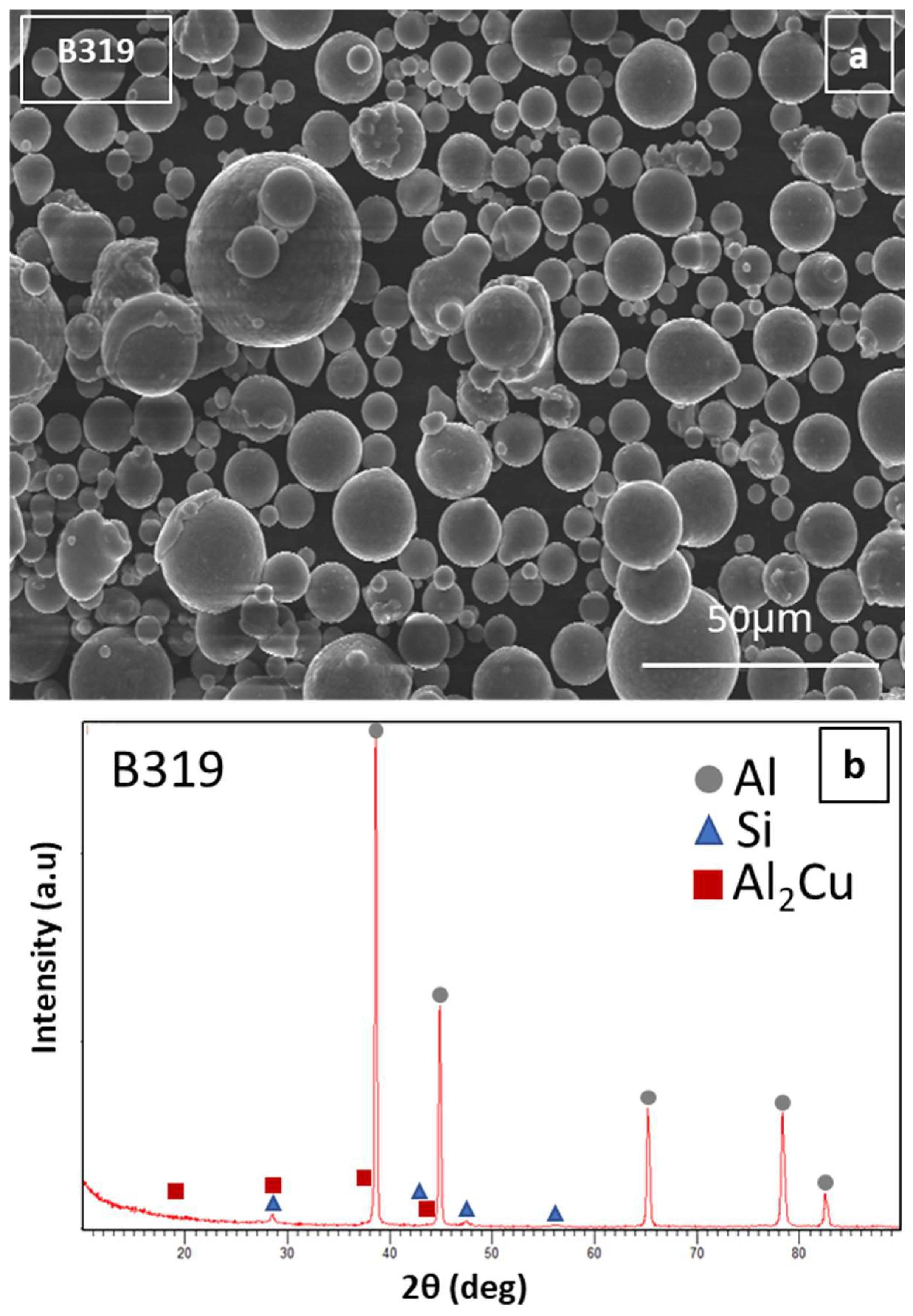
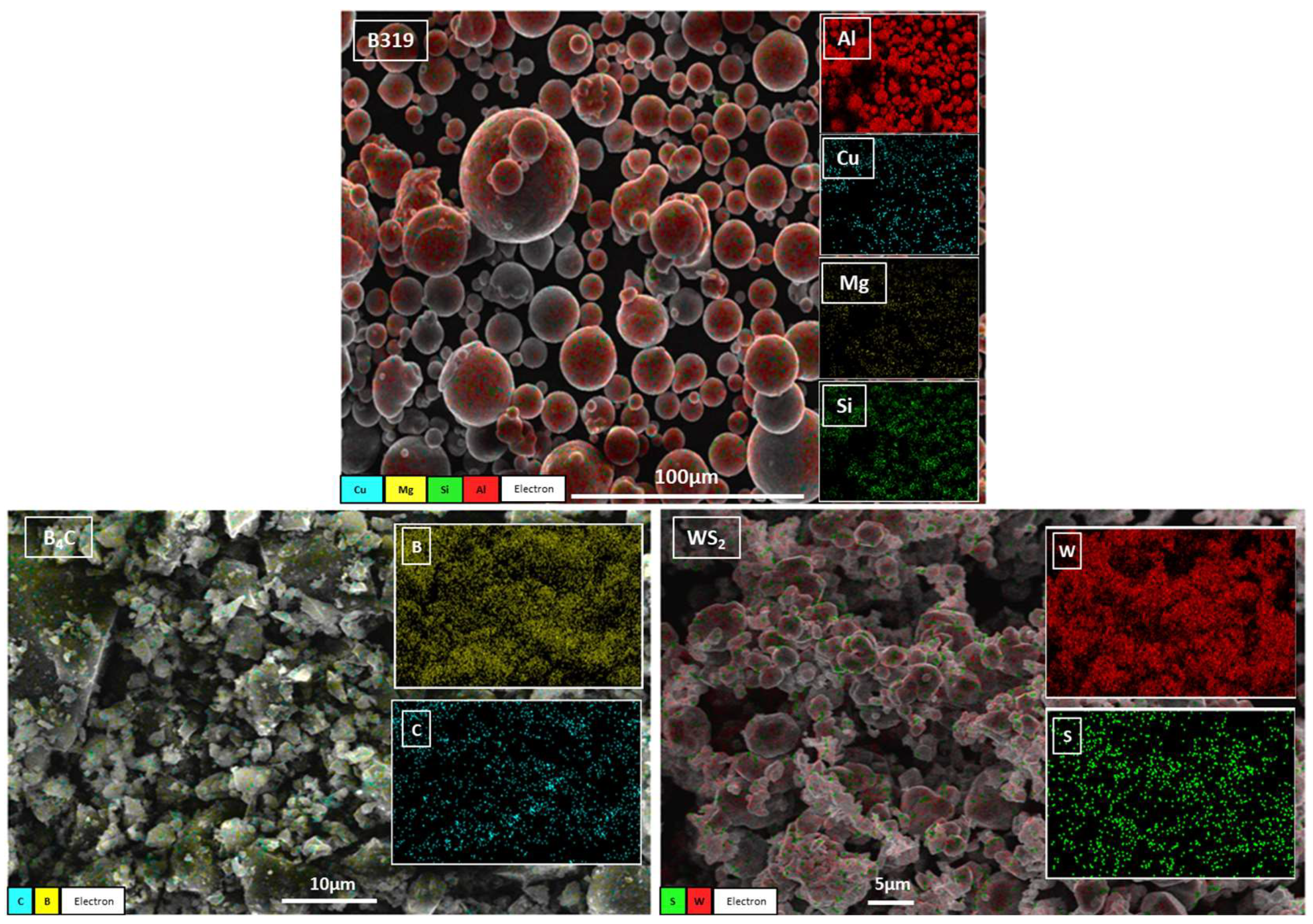
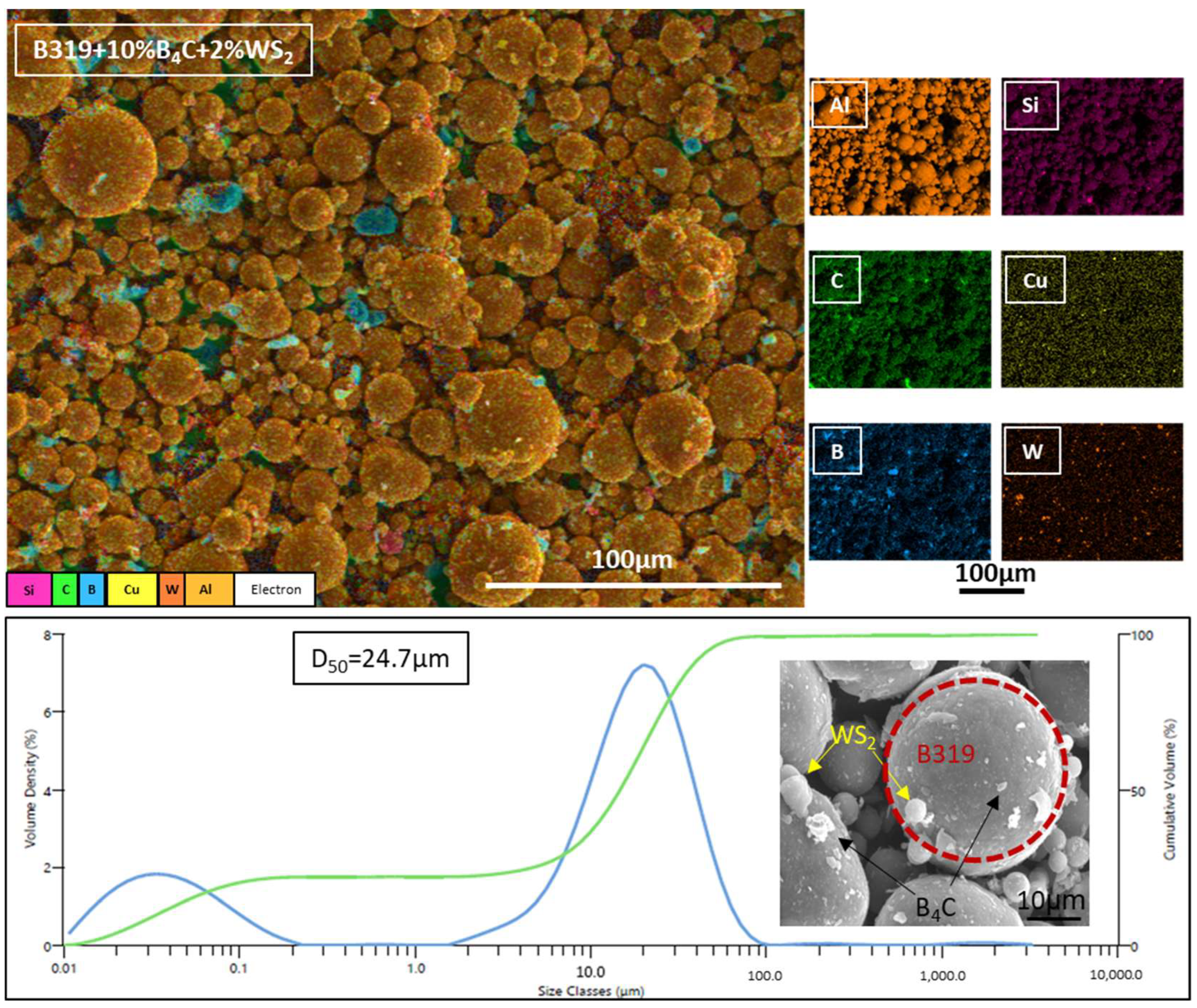
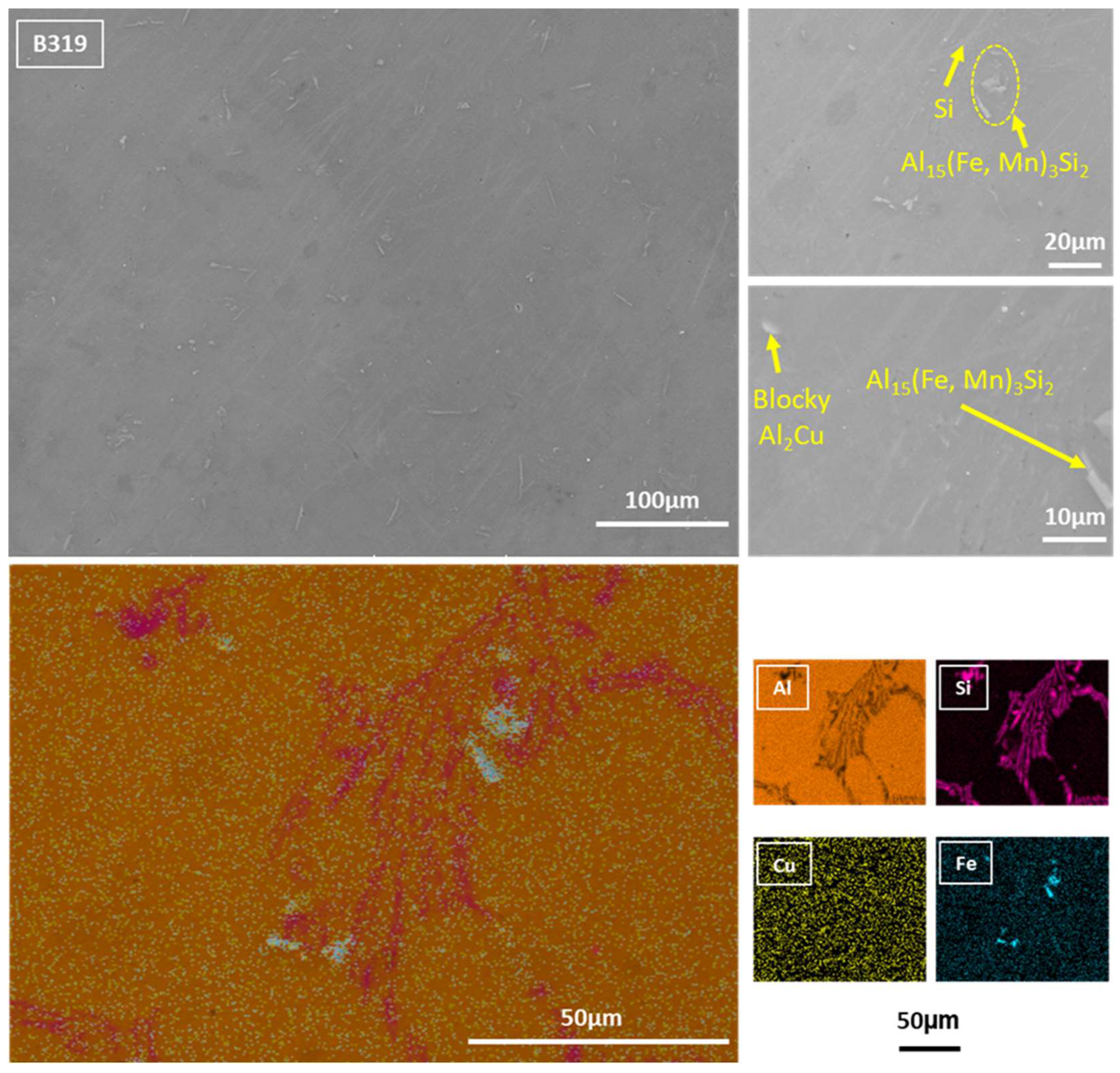
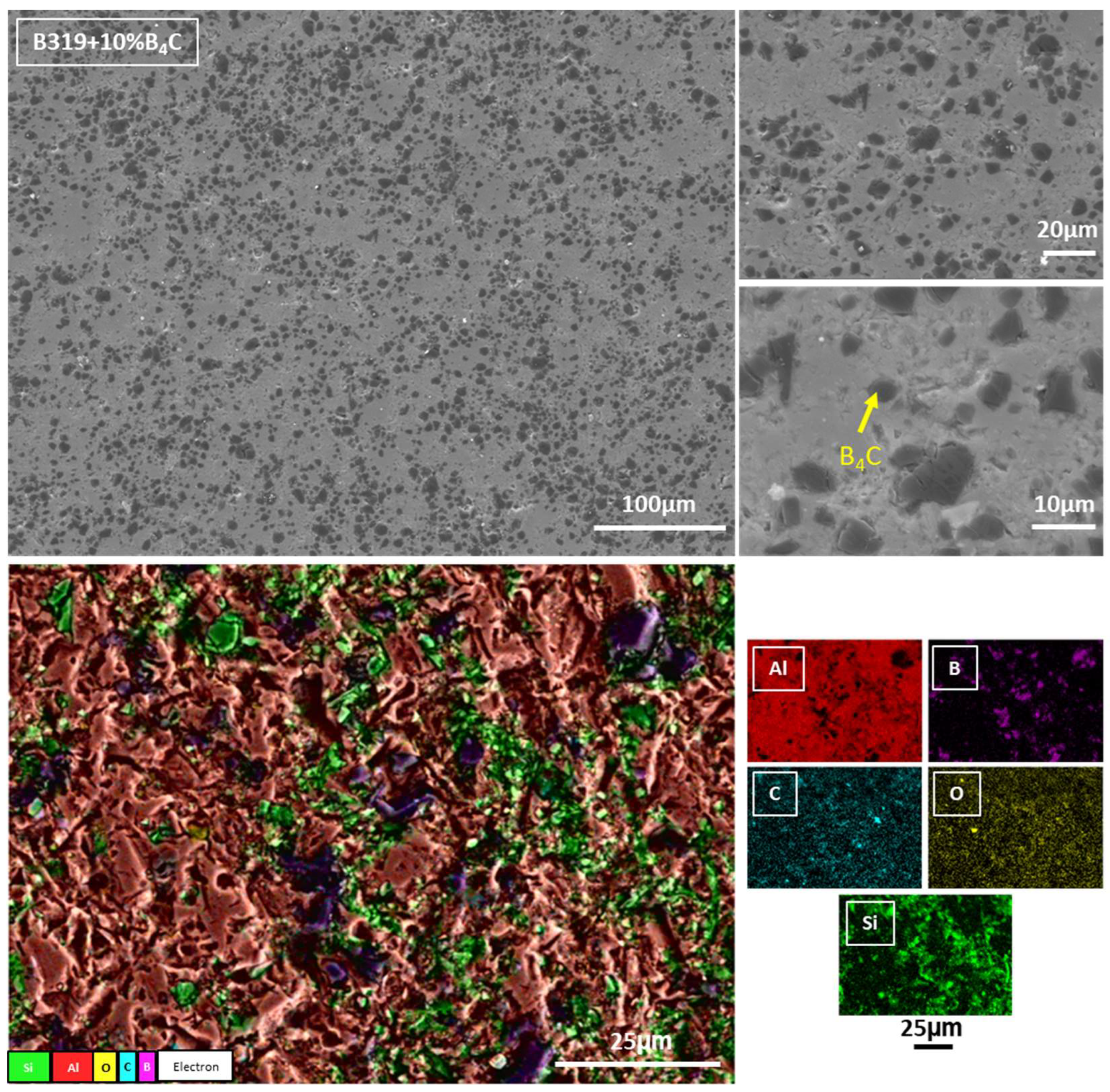
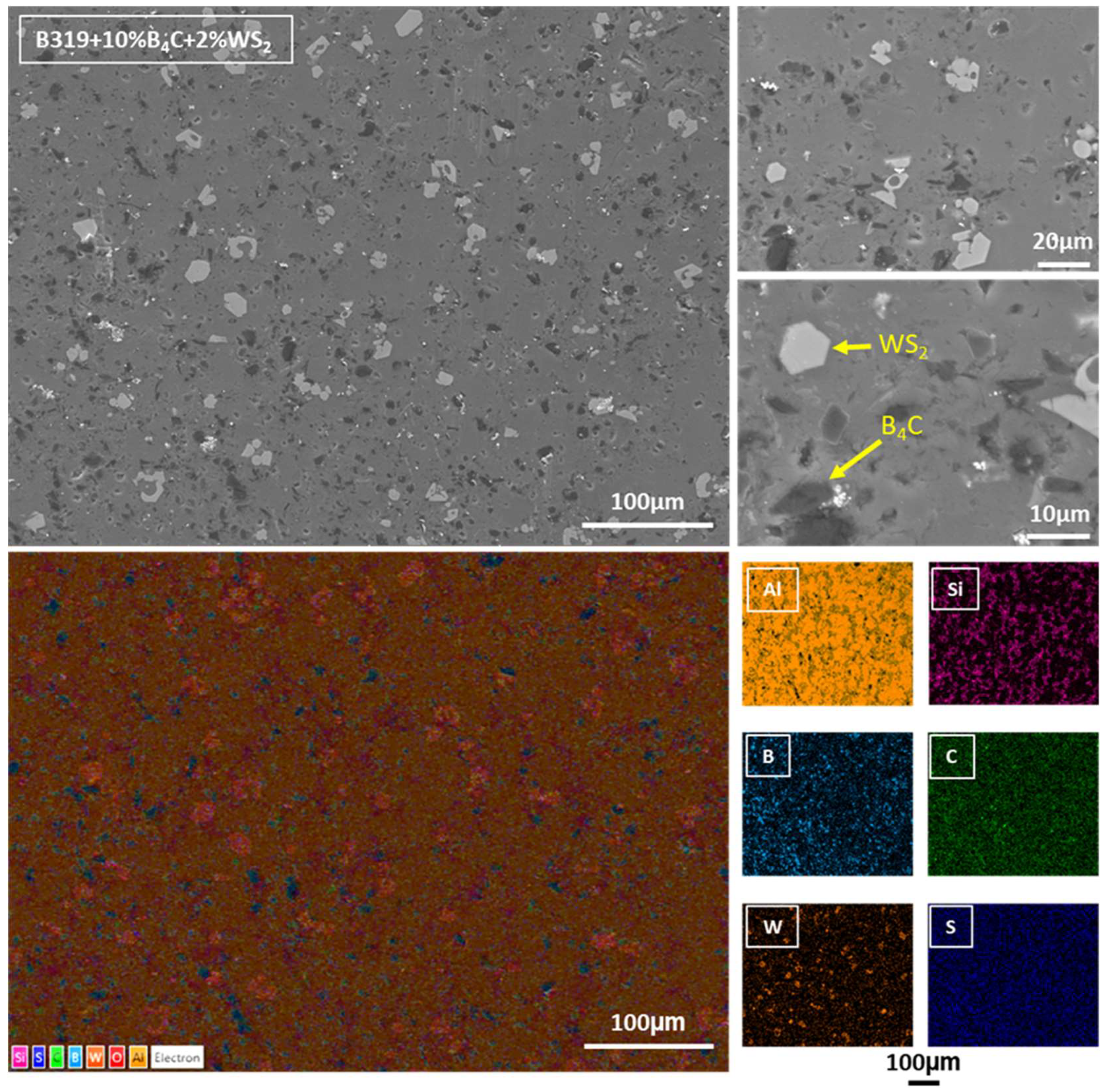
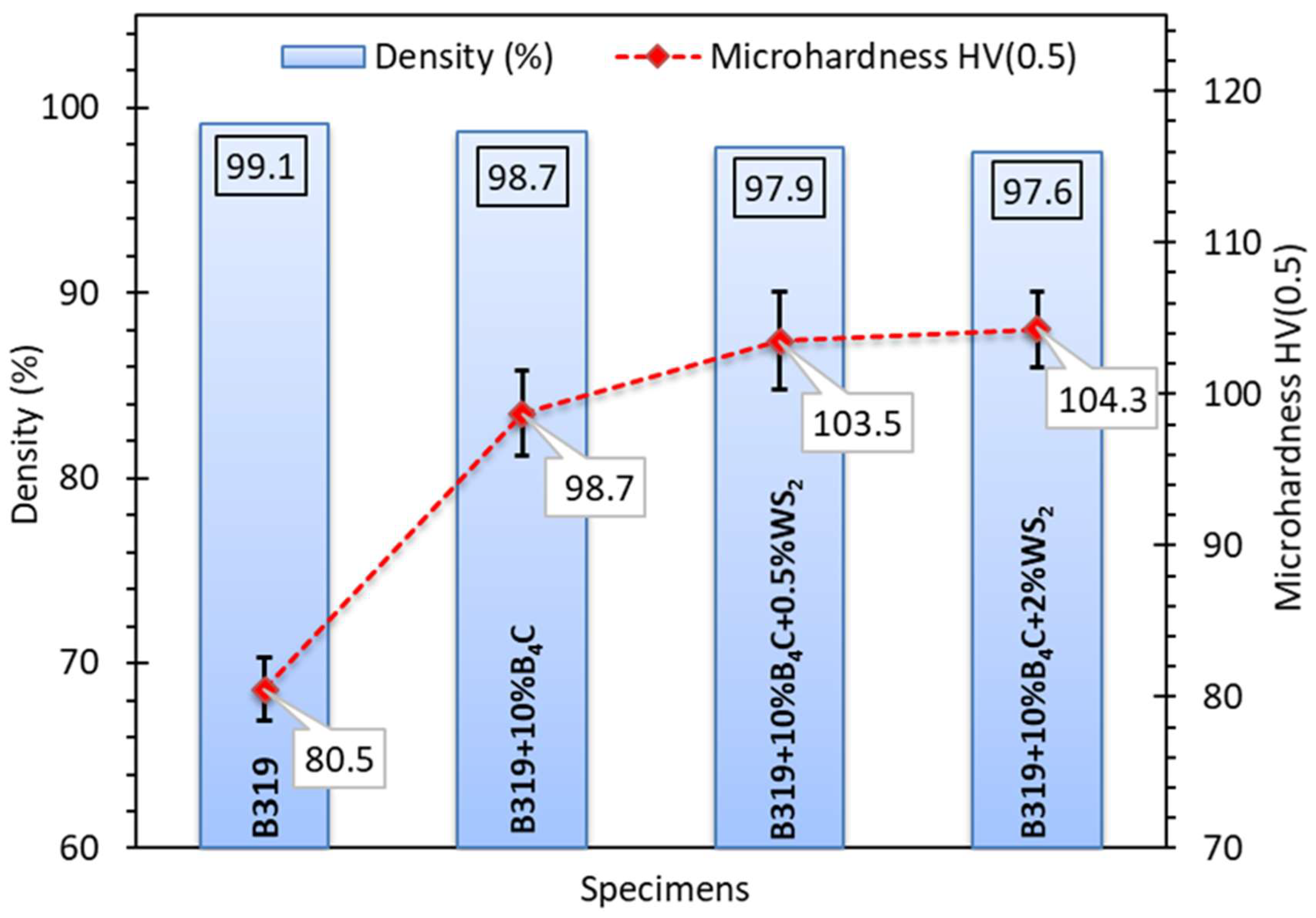
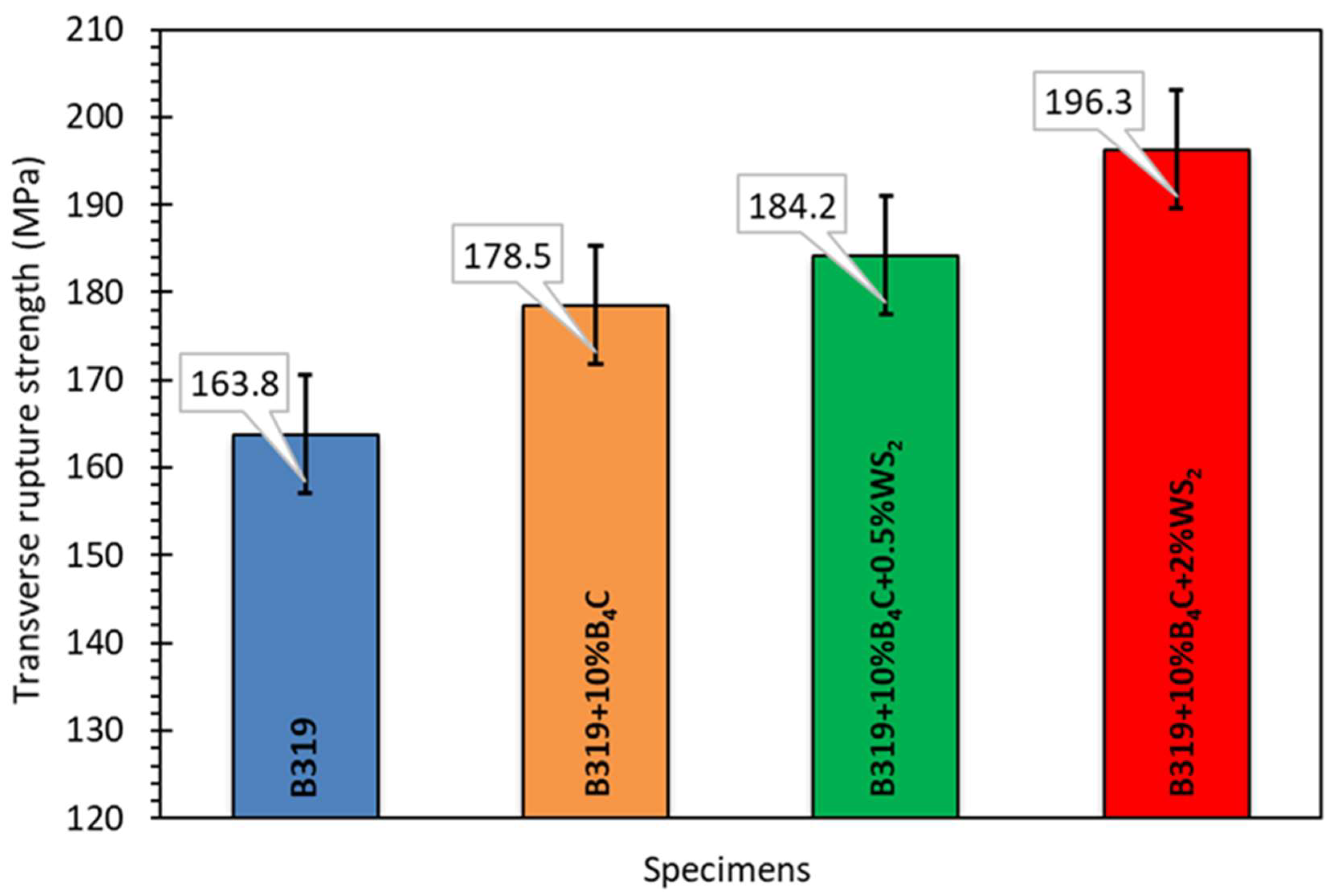

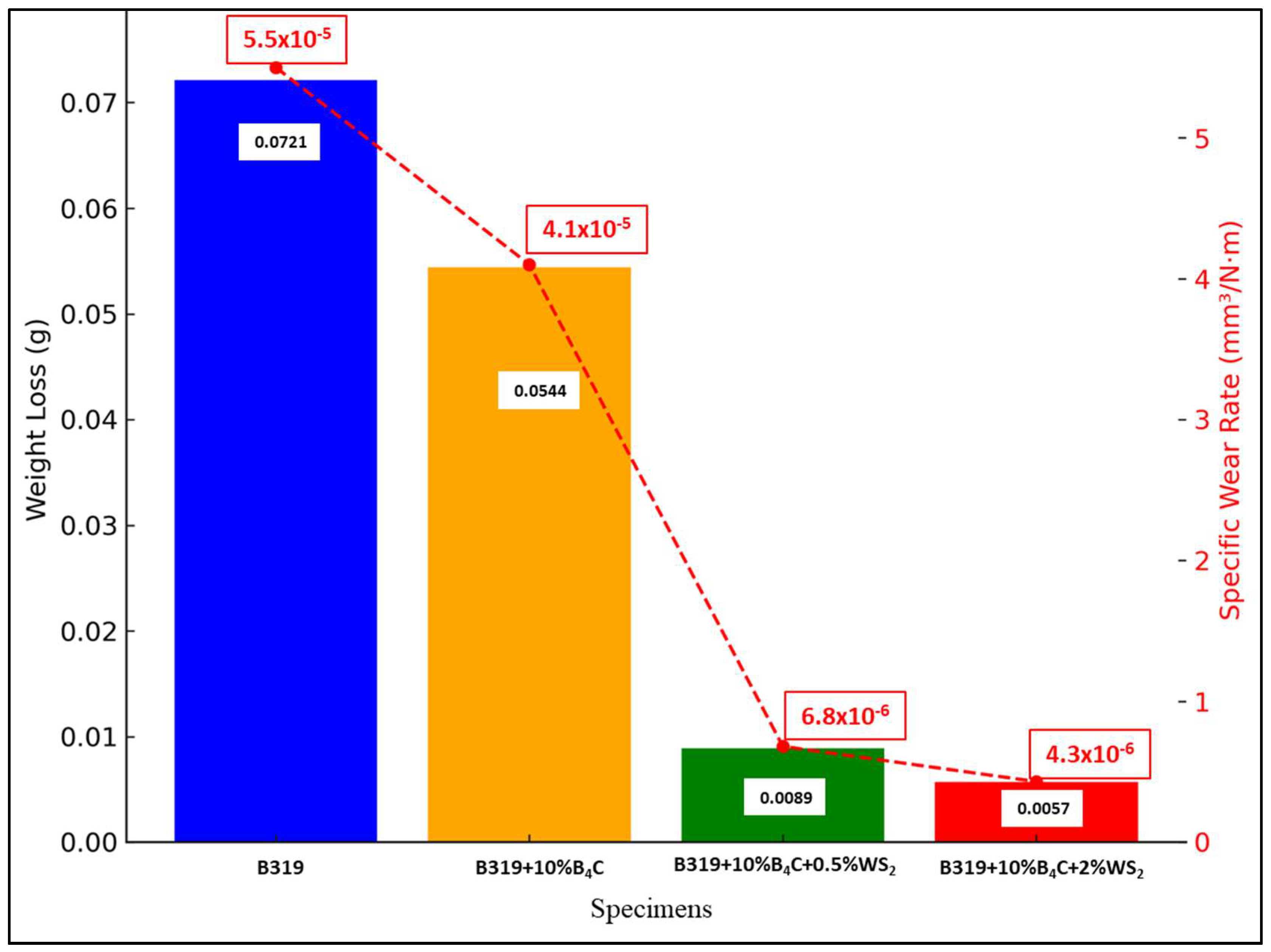

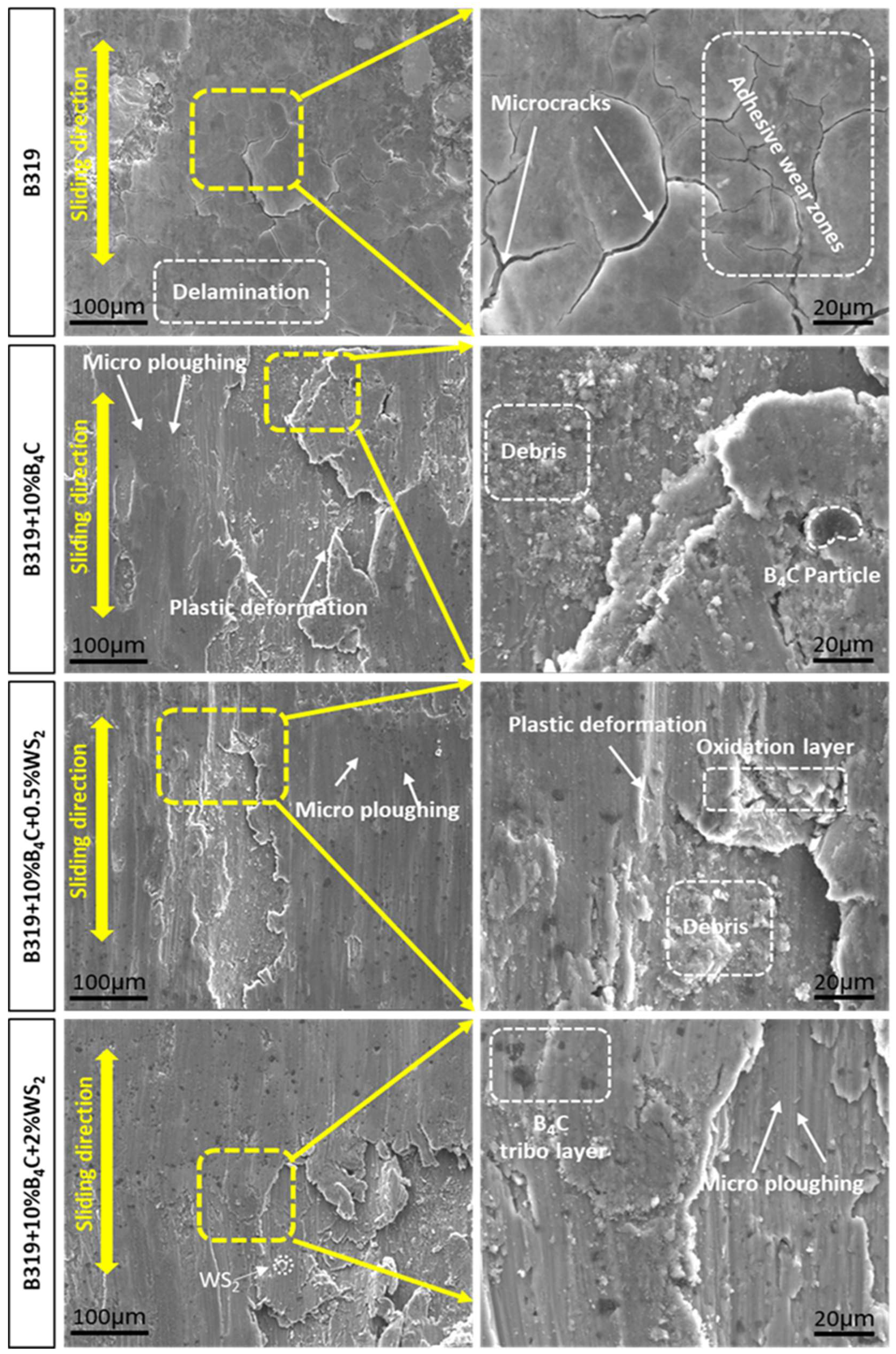
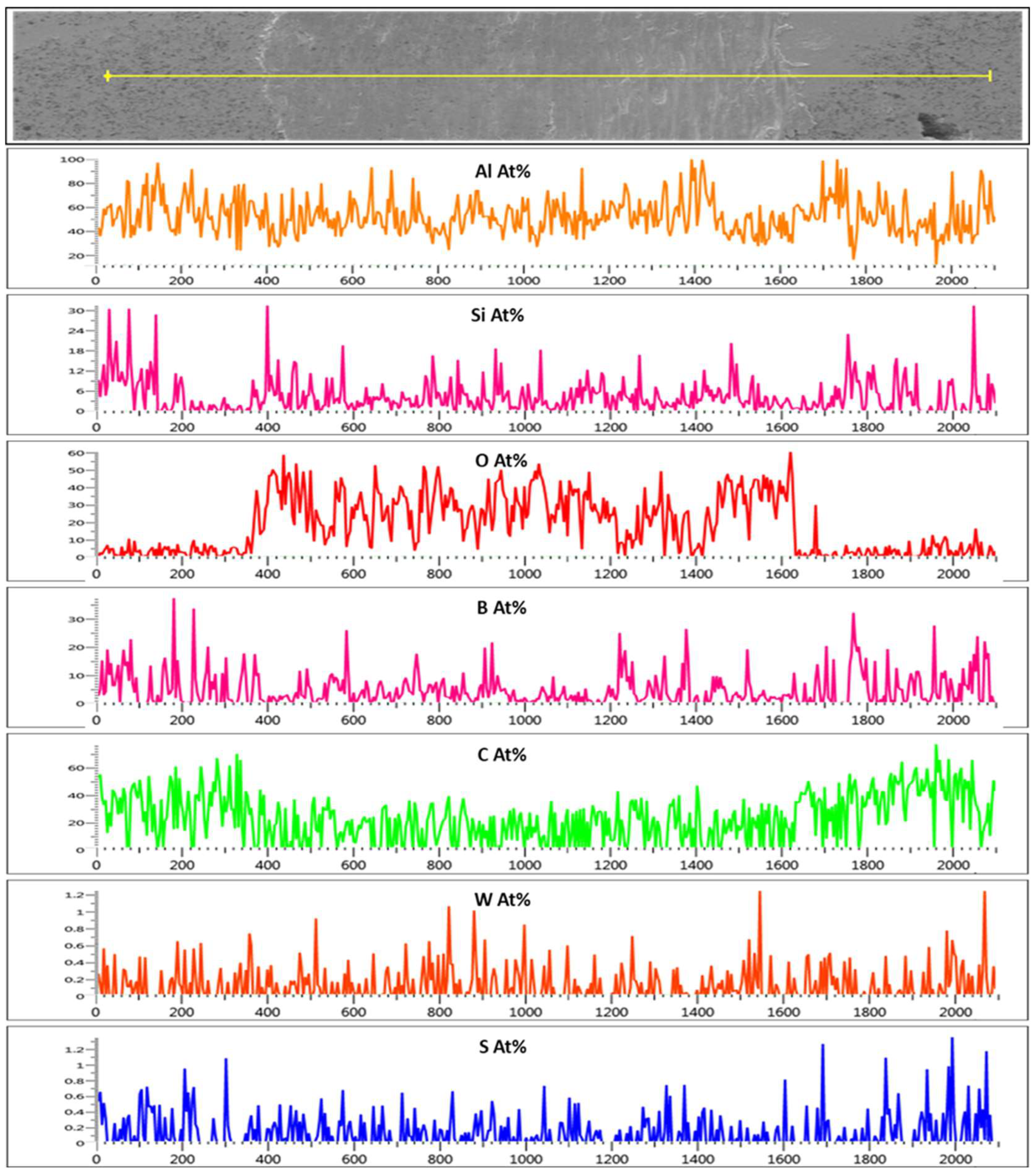
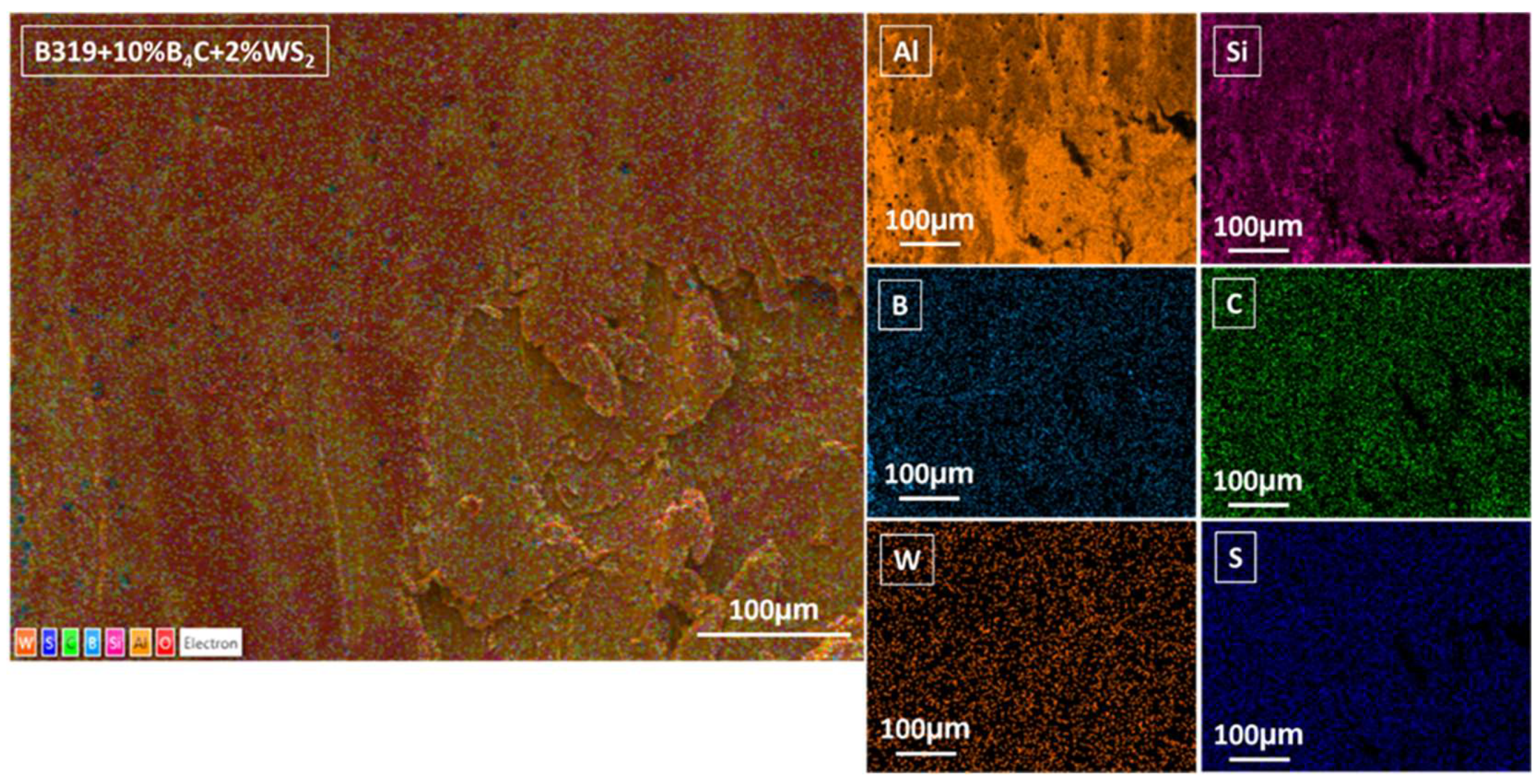
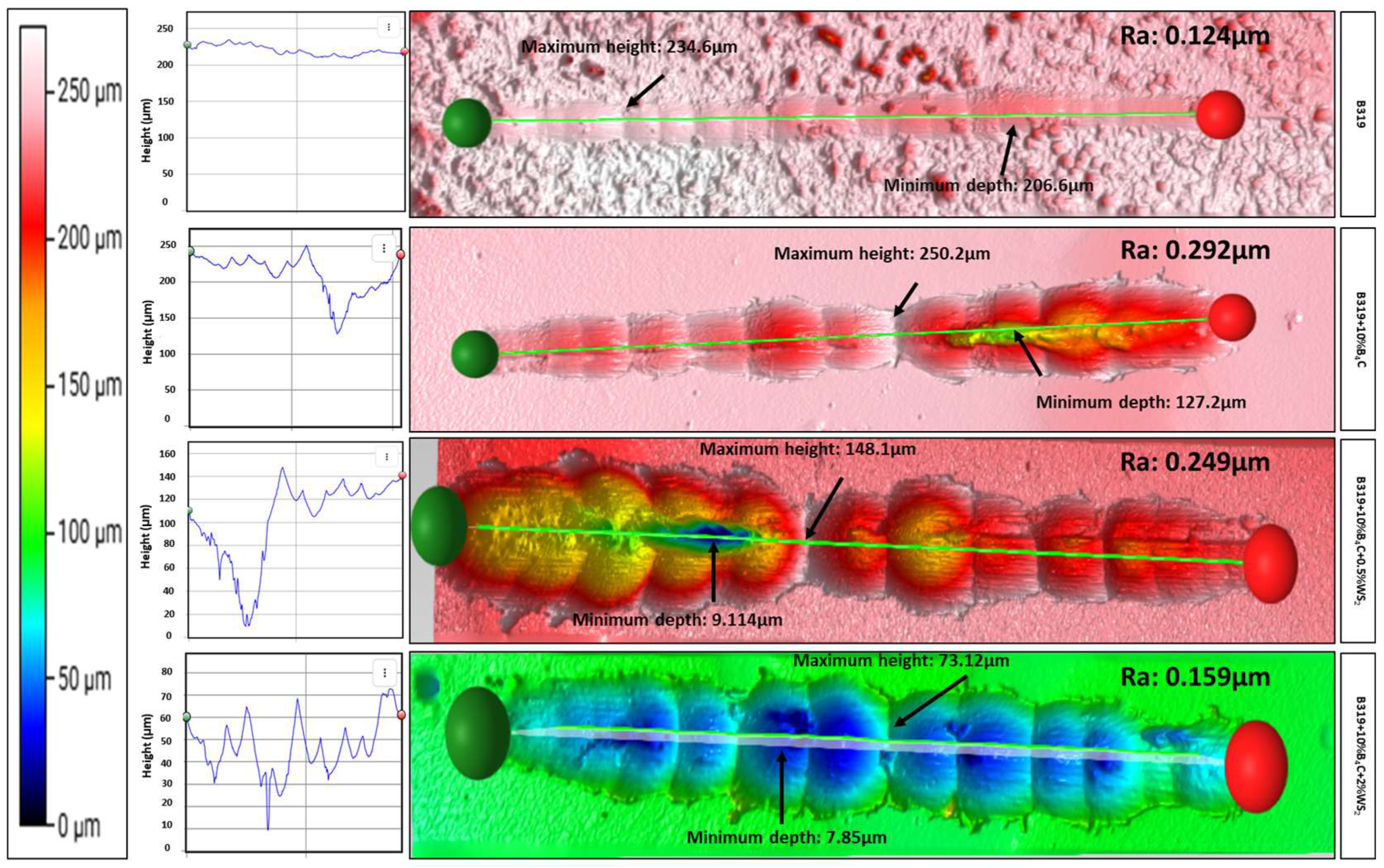
Disclaimer/Publisher’s Note: The statements, opinions and data contained in all publications are solely those of the individual author(s) and contributor(s) and not of MDPI and/or the editor(s). MDPI and/or the editor(s) disclaim responsibility for any injury to people or property resulting from any ideas, methods, instructions or products referred to in the content. |
© 2025 by the author. Licensee MDPI, Basel, Switzerland. This article is an open access article distributed under the terms and conditions of the Creative Commons Attribution (CC BY) license (https://creativecommons.org/licenses/by/4.0/).
Share and Cite
Tasci, U. Microstructure, Mechanical Strength, and Tribological Behavior of B4C/WS2-Hybrid-Reinforced B319 Aluminum Matrix Composites. Lubricants 2025, 13, 247. https://doi.org/10.3390/lubricants13060247
Tasci U. Microstructure, Mechanical Strength, and Tribological Behavior of B4C/WS2-Hybrid-Reinforced B319 Aluminum Matrix Composites. Lubricants. 2025; 13(6):247. https://doi.org/10.3390/lubricants13060247
Chicago/Turabian StyleTasci, Ufuk. 2025. "Microstructure, Mechanical Strength, and Tribological Behavior of B4C/WS2-Hybrid-Reinforced B319 Aluminum Matrix Composites" Lubricants 13, no. 6: 247. https://doi.org/10.3390/lubricants13060247
APA StyleTasci, U. (2025). Microstructure, Mechanical Strength, and Tribological Behavior of B4C/WS2-Hybrid-Reinforced B319 Aluminum Matrix Composites. Lubricants, 13(6), 247. https://doi.org/10.3390/lubricants13060247




